 | ÐлекÑÑоннÑй компоненÑ: SP7652EB | СкаÑаÑÑ:  PDF PDF  ZIP ZIP |
Äîêóìåíòàöèÿ è îïèñàíèÿ www.docs.chipfind.ru

Rev 07/07/04 SP7652 Evaluation Manual Copyright 2004 Sipex Corporation
SP7652EB SCHEMATIC
Easy Evaluation for the
SP7652EU 0 to 28V Input, 0 to 8A
Output Synchronous Buck
Converter
Built in Low Rds(on) Power FETs
UVLO Detects Both VCC and VIN
High Integrated Design, Minimal
Components
High Efficiency: 90%
Feature Rich: UVIN, Programmable
Softstart, External VCC Supply and
Output Dead Short Circuit Shutdown
SP7652
Evaluation Board Manual

2
USING THE EVALUATION BOARD
1) Powering Up the SP7652EB Circuit
Connect the SP7652 Evaluation Board with an external +12V power supply. Connect
with short leads and large diameter wire directly to the "VIN" and "GND" posts. Connect
a Load between the VOUT and GND2 posts, again using short leads with large
diameter wire to minimize inductance and voltage drops.
2) Measuring Output Load Characteristics
It's best to GND reference scope and digital meters using the Star GND post in the
center of the board. VOUT ripple can best be seen touching probe tip to the pad for C3
and scope GND collar touching Star GND post avoid a GND lead on the scope which
will increase noise pickup.
3) Using the Evaluation Board with Different Output Voltages
While the SP7652 Evaluation Board has been tested and delivered with the output set
to 3.30V, by simply changing one resistor, R2, the SP7652 can be set to other output
voltages. The relationship in the following formula is based on a voltage divider from the
output to the feedback pin VFB, which is set to an internal reference voltage of 0.80V.
Standard 1% metal film resistors of surface mount size 0603 are recommended.
Vout = 0.80V ( R1 / R2 + 1 ) => R2 = R1 / [ ( Vout / 0.80V ) 1 ]
Where R1 = 68.1K
and for Vout = 0.80V setting, simply remove R2 from the board.
Furthermore, one could select the value of R1 and R2 combination to meet the exact
output voltage setting by restricting R1 resistance range such that 50K
R1 100K
for overall system loop stability.
Note that since the SP7652 Evaluation Board design was optimized for 12V down
conversion to 3.30V, changes of output voltage and/or input voltage will alter
performance from the data given in the Power Supply Data section. In addition, the
SP7652EU provides short circuit protection by sensing Vout at GND.
POWER SUPPLY DATA
The SP7652EU is designed with a very accurate 1.0% reference over line, load and
temperature. Figure 1 data shows a typical SP7652 Evaluation Board Efficiency plot,
with efficiencies to 90% and output currents to 8A. SP7652EU Load Regulation is
shown in Figure 2 of only 0.4% change in output voltage from no load to 8A load.
Figures 3 and 4 illustrate a 4A to 8A and 0A to 8A Load Step. Start-up Response in
Figures 5, 6 and 7 show a controlled start-up with different output load behavior when
power is applied where the input current rises smoothly as the Softstart ramp increases.
In Figure 8 the SP7652EU is configured for hiccup mode in response to an output dead
short circuit condition and will Softstart until the over-load is removed. Figure 9 and 10
show output voltage ripple less than 50mV at no load to 8A load.
While data on individual power supply boards may vary, the capability of the SP7652EU
of achieving high accuracy over a range of load conditions shown here is quite
impressive and desirable for accurate power supply design.
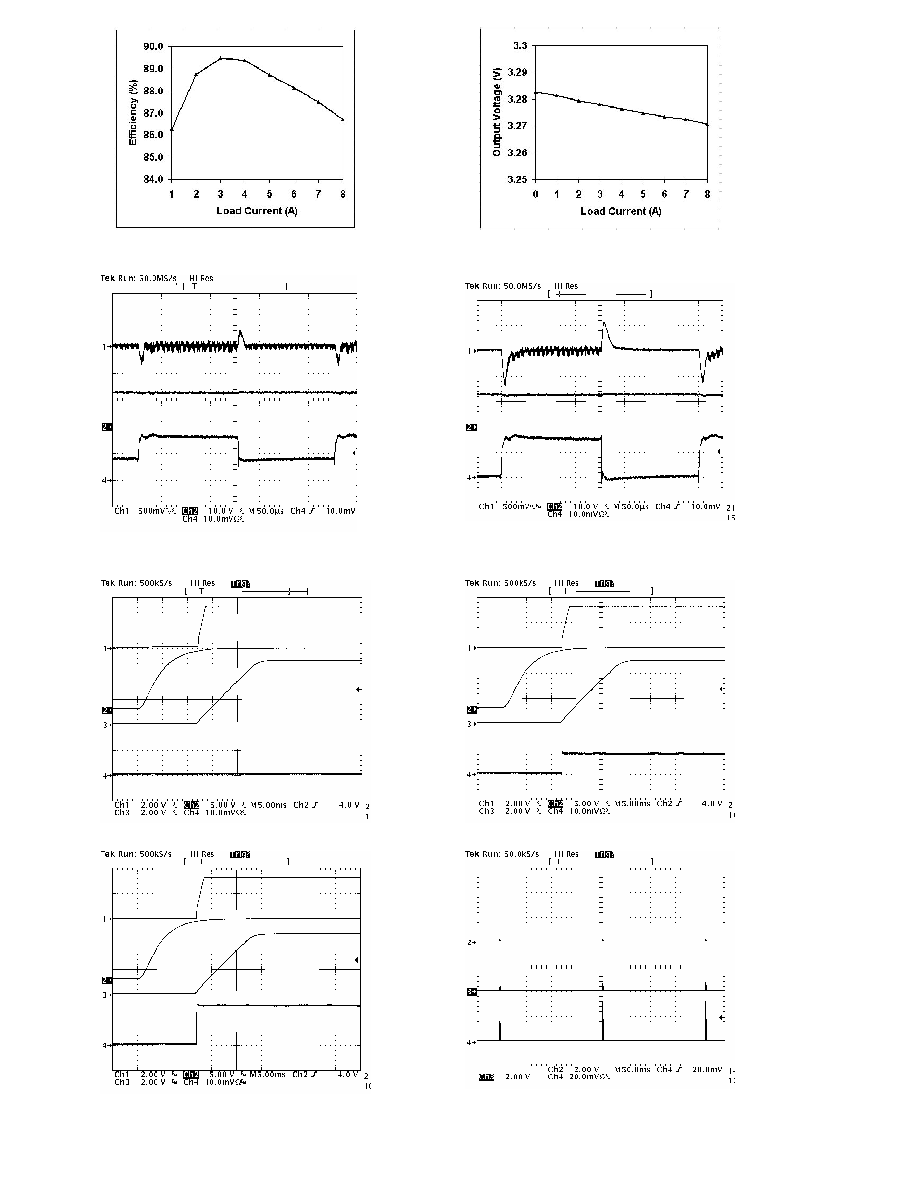
3
Figure 1. Efficiency vs Load
Figure 2. Load Regulation
Figure 3. Load Step Response: 4->8A
Figure 4. Load Step Response: 0->8A
Figure 5. Start-Up Response: No Load
Figure 6. Start-Up Response: 4A Load
Figure 7. Start-Up Response: 8A Load Figure 8. Output Load Short Circuit
SoftStart
Vout
Vin=12V
Vout=3.3V
Vout
Vin
Iout (5A/div)
Vin=12V
Vout=3.3V
Vout
Vin
Vout
Vin
SoftStart
Iout (5A/div)
SoftStart
Vout
Vin
Iout (5A/div)
Iout (5A/div)
Vin
Vout
Ichoke (5A/div)
Iout (5A/div)
Vin=12V
Vout=3.3V
Vin=12V
Vout=3.3V
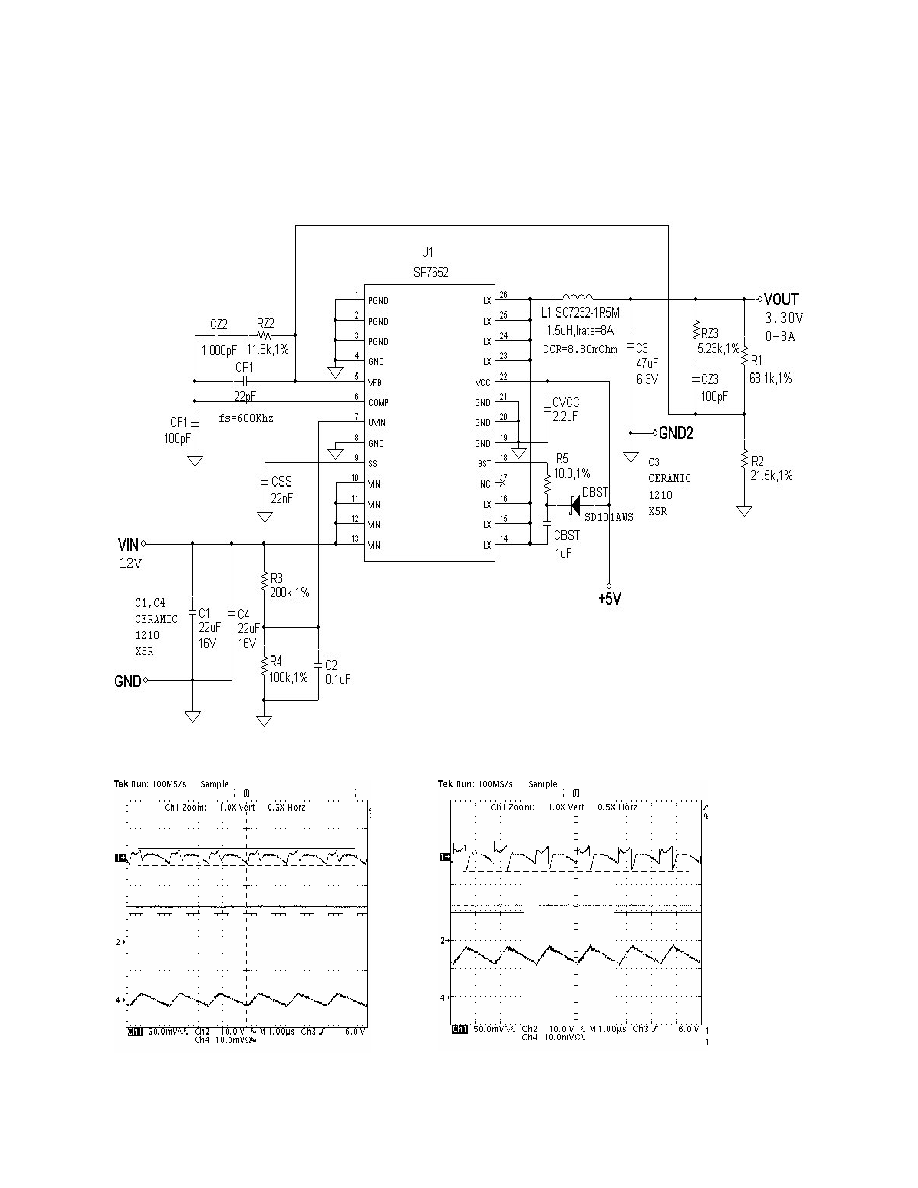
4
+5V BIAS SUPPLY APPLICATION SCHEMATIC
In this application example, the SP7652EU is power by an external +5V bias supply
which current consumption of 20mA Maximum. If this supply is not available than it is
recommend Sipex SPX5205 Low-Noise LDO Voltage Regulator which is included on
the SP7652 Evaluation Board.
Figure 9. Output Ripple: No Load Figure 10. Output Ripple: 8A Load
Vout ripple = 30mV
Vout ripple = 50mV
Vin
Ichoke(5A/div)
Vin
Ichoke (5A/div)
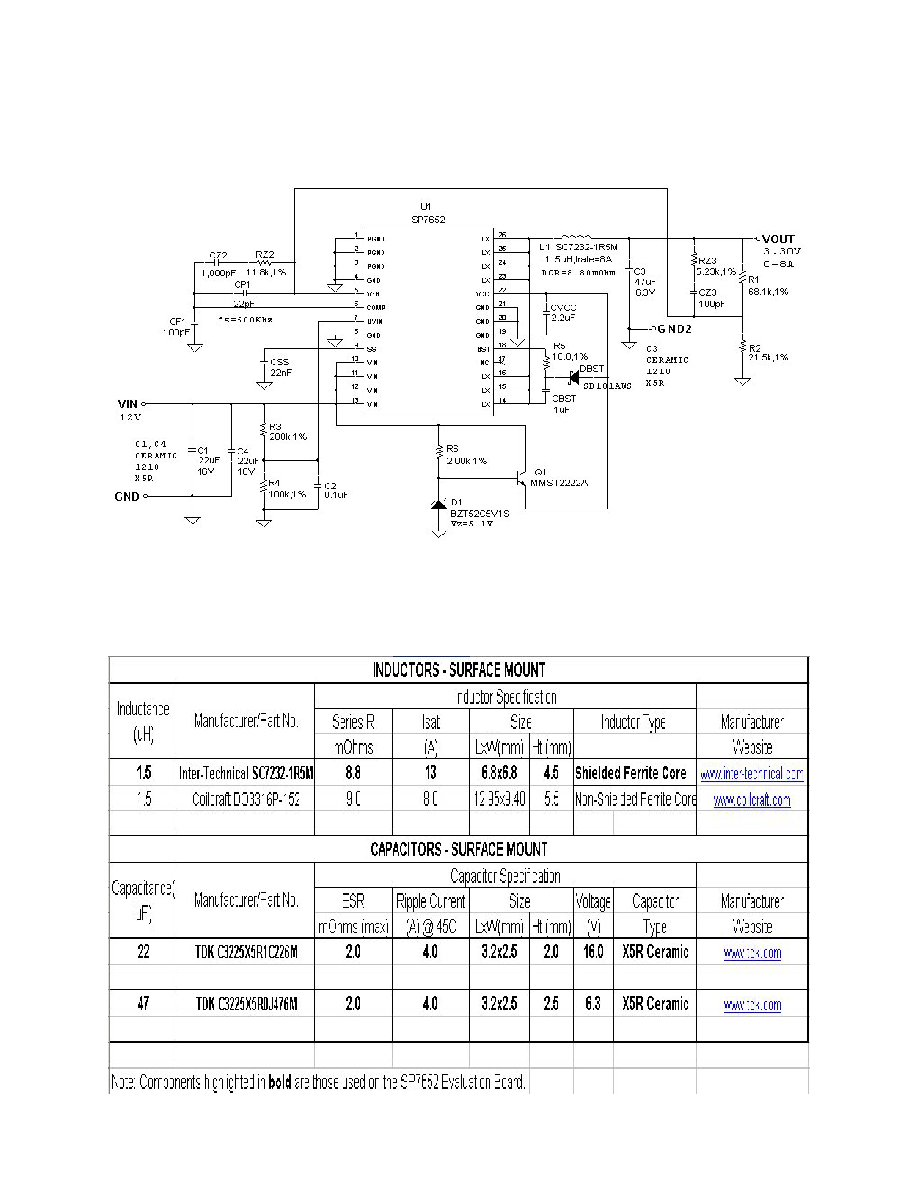
5
DIFFERENT +5V BIAS SUPPLY SCHEMES APPLICATION SCHEMATIC
The SP7652EU VCC Bias Supply can be derived from Vin or external bias with several
biasing options. The transistor plus zener diode +5V bias supply could also be used as
shown in Figure 11.
Figure 11. Transistor plus Zener Diode +5V Supply Application Schematic
Table 1: SP7652EB Suggested Components and Vendor Lists
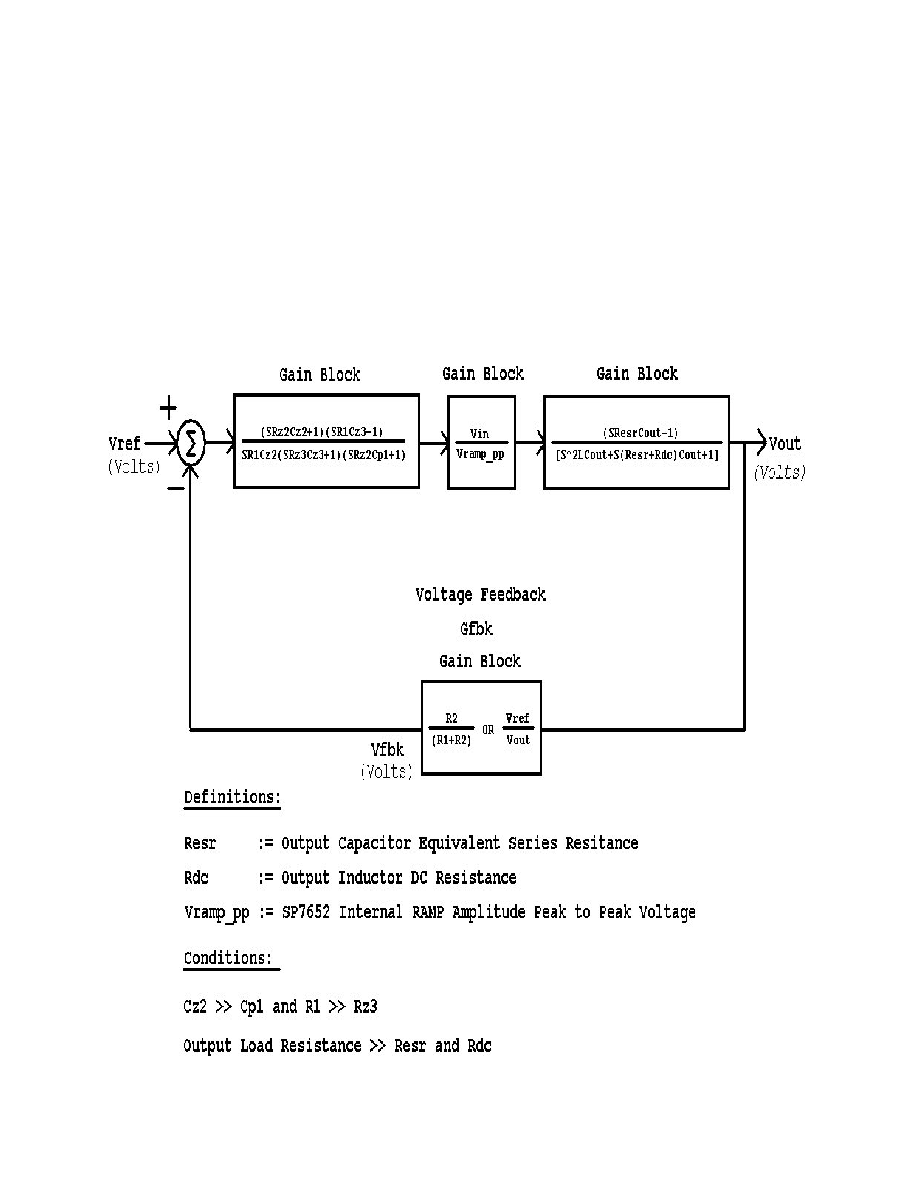
6
TYPE III LOOP COMPENSATION DESIGN
The open loop gain of the SP7652EB can be divided into the gain of the error amplifier
Gamp(s), PWM modulator Gpwm, buck converter output stage Gout(s), and feedback
resistor divider Gfbk. In order to crossover at the selecting frequency fco, the gain of
the error amplifier has to compensate for the attenuation caused by the rest of the loop
at this frequency. The goal of loop compensation is to manipulate the open loop
frequency response such that its gain crosses over 0dB at a slope of 20dB/dec. The
open loop crossover frequency should be higher than the ESR zero of the output
capacitors but less than 1/5 to 1/10 of the switching frequency fs to insure proper
operation. Since the SP7652EB is designed with Ceramic Type output capacitors, a
Type III compensation circuit is required to give a phase boost of 180
° in order to
counteract the effects of the output LC under damped resonance double pole
frequency.
Figure 12. Voltage Mode Control Loop with Loop Dynamic for Type III Compensation

7
The simple guidelines for positioning the poles and zeros and for calculating the
component values for Type III compensation are as follows.
a. Choose
fco = fs / 10
b. Calculate
fp_LC
fp_LC = 1 / 2
[(L) (C)] ^ 1/2
c. Calculate
fz_ESR
fz_ESR = 1 / 2
(Resr) (Cout)
d. Select
R1 component value such that 50k
R1 100k
e. Calculate
R2 base on the desired Vout
R2 = R1 / [(Vout / 0.80V) 1]
f.
Select the ratio of Rz2 / R1 gain for the desired gain bandwidth
Rz2 = R1 (Vramp_pp / Vin_max) (fco / fp_LC)
g. Calculate
Cz2 by placing the zero at ½ of the output filter pole frequency
Cz2 = 1 /
(Rz2) (fp_LC)
h. Calculate
Cp1 by placing the first pole at ESR zero frequency
Cp1 = 1 / 2
(Rz2) (fz_ESR)
i. Calculate
Rz3 by setting the second pole at ½ of the switching frequency and the
second zero at the output filter double pole frequency
Rz3 = 2 (R1) (fp_LC) / fs
j. Calculate
Cz3 from Rz3 component value above
Cz3 = 1 /
(Rz3) (fs)
k. Choose
100pF
Cf1 220pF to stabilize the SP7652EU internal Error Amplify
As a particular example, consider for the following SP7652EB with a Type III Voltage
Loop Compensation component selections:
Vin = 5 to 15V
Vout = 3.30V @ 0 to 8A load
Select L = 1.5uH => yield
35% of maximum 8A output current ripple.
Select Cout = 47uF Ceramic capacitor (Resr
2m)
fs = 600khz SP7652 internal Oscillator Frequency
Vramp_pp = 1.0V SP7652 internal Ramp Peak to Peak Amplitude
Step by step design procedures:
a.
fco = 600khz / 10 = 60khz
b.
fp_LC = 1 / 2
[(1.5uH)(47uF)]^1/2 20khz
c.
fz_ESR = 1 / 2
(2m)(47uF) 1.7Mhz
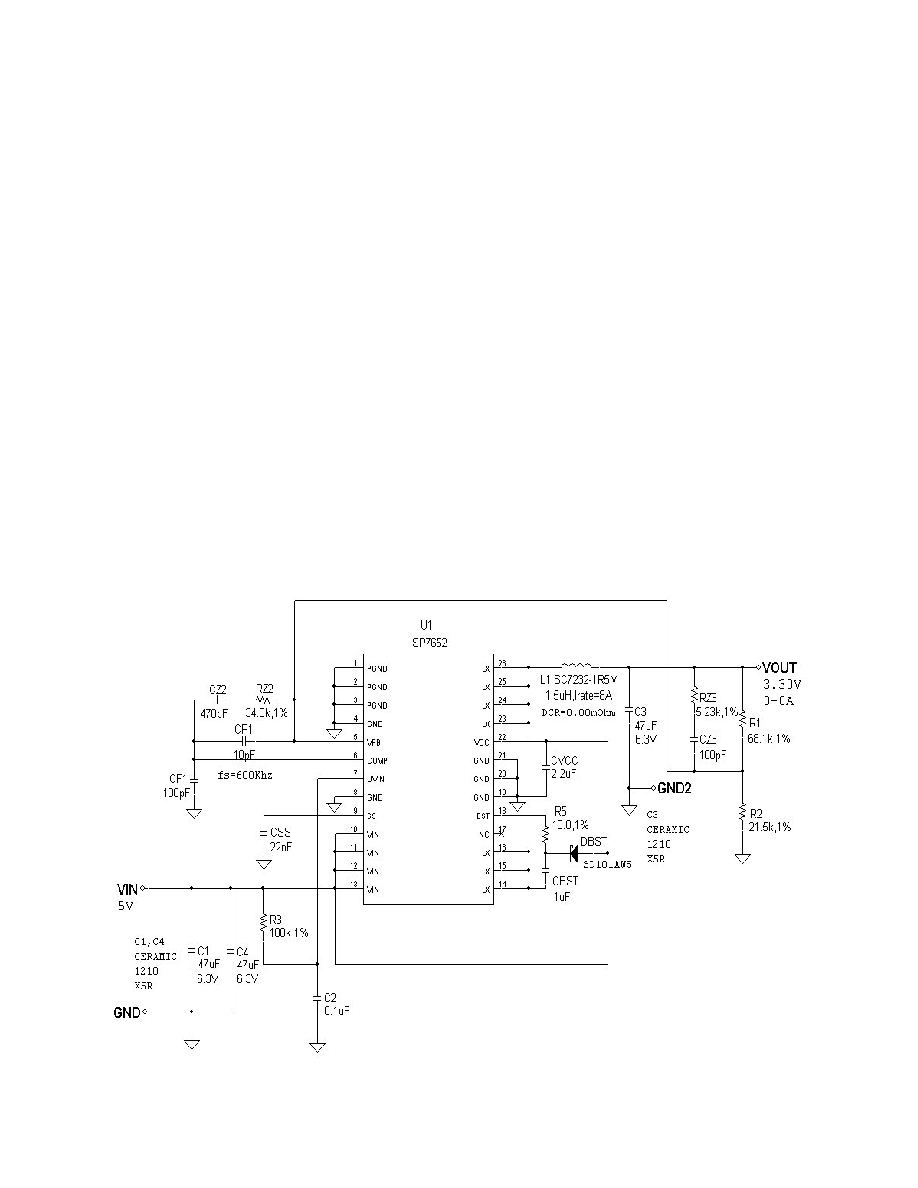
8
d.
R1 = 68.1k
, 1%
e.
R2 = 68.1k
/ [(3.30V / 0.80V) 1] 21.5k, 1%
f.
Rz2 = 68.1k
(1.0V / 15V) (60khz / 20khz) 11.8k, 1%
g.
Cz2 = 1 /
(11.8k) (20khz) 1,000pF, X7R
h.
Cp1 = 1 / 2
(11.8k) (1.7Mhz) 10pF => Select Cp1 = 22pF for noise filtering
i.
Rz3 = 2 (68.1k
) (20khz) / 600khz 5.23k, 1%
j.
Cz3 = 1 /
(5.23k) (600khz) 100pF, COG
k.
Cf1 = 100pF to stabilize SP7652EU internal Error Amplify
+5V INPUT WITH A TYPE III COMPENSATION APPLICATION SCHEMATIC
Figure 13 shows another example of SP7652EU configures for +5V input by simply
changing a few external resistors and capacitors components value for delivering a 0-
8A output with excellent line and load regulation.
Figure 13. SP7652EU Configures for Vin = 5V, Vout = 3.3V at 0-8A Output Load Current
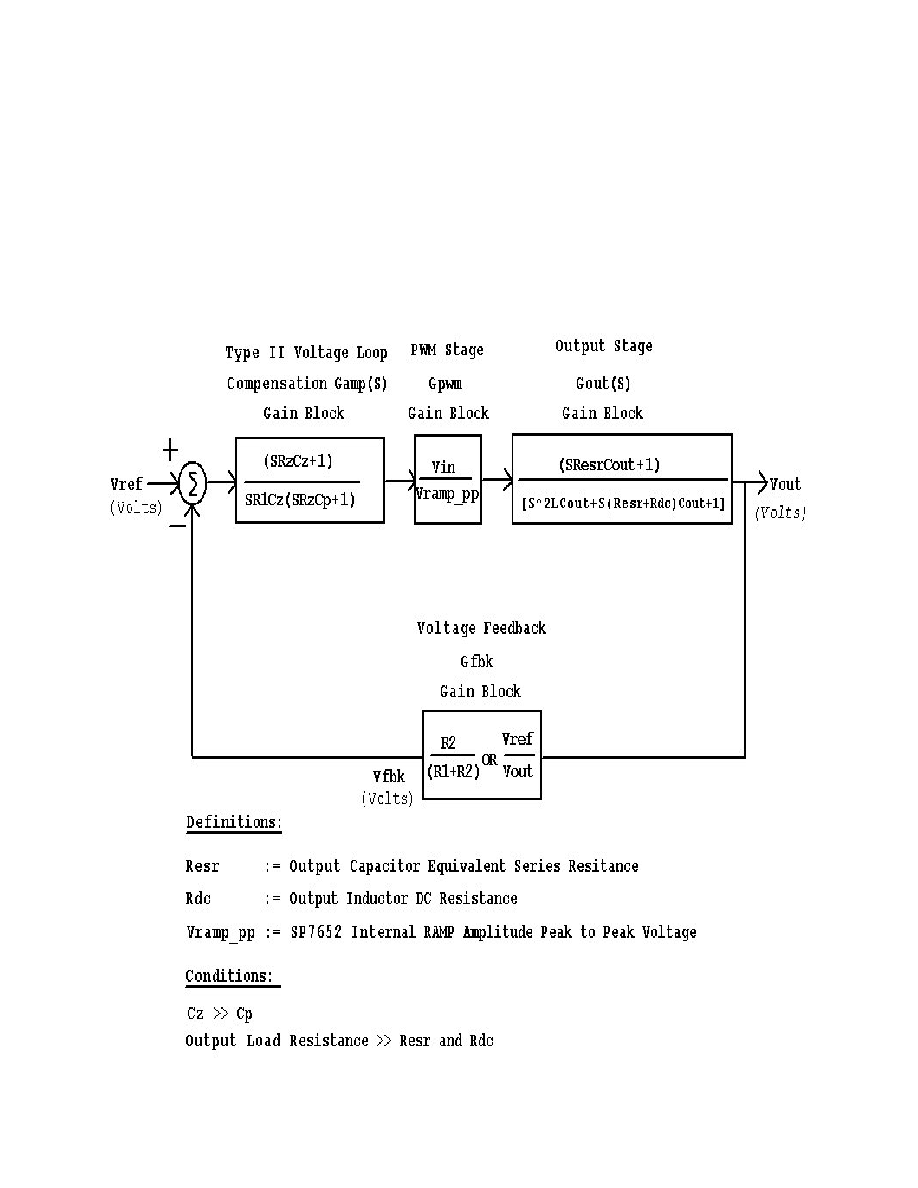
9
TYPE II LOOP COMPENSATION DESIGN
Type II compensation is specifically used when an Electrolytic or Tantalum output
capacitor is chosen at the converter output due to its low cost. In that case, the zero
caused by the output capacitor ESR is within a few khz and this is of course greatly
simplifying the voltage loop compensation design. By adding an additional zero in the
compensation loop before the first pole, the voltage loop bandwidth is extended with a
90º phase boost and hence the overall transient response time is improved. Most
previous guidelines for calculating the component values for Type III compensation can
be carries over for Type II except for the new Rz, Cz and Cp components. Note that
Rz2, Cz2, Cp1, Rz3, and Cz3 components are not required for the Type II Loop
Compensation Design.
Figure 14. Voltage Mode Control Loop with Loop Dynamic for Type II Compensation

10
f.
Select the ratio of Rz / R1 gain for the desired gain bandwidth
Rz = R1 (Vramp_pp / Vin_max) (fco) [fz_ESR / (fp_LC) ^ 2]
g. Calculate
Cz by placing the zero at 1/10 of the output filter pole frequency
Cz = 1 / 0.1(2
) (Rz) (fp_LC)
h. Calculate
Cp by placing the second pole at ½ of the switching frequency
Cp = 1 /
(Rz) (fs)
As a particular example, consider for the following SP7652EB with a Type II Voltage
Loop Compensation component selections:
Vin = 5 to 15V
Vout = 3.30V @ 0 to 8A load
Select L = 1.5uH => yield
35% of maximum 8A output current ripple.
Select Cout = 330uF Tantalum capacitor (Resr
10m)
fs = 600khz SP7652 internal Oscillator Frequency
Vramp_pp = 1.0V SP7652 internal Ramp Peak to Peak Amplitude
Step by step design procedures:
a.
fco = 600khz / 10 = 60khz
b.
fp_LC = 1 / 2
[(1.5uH) (330uF)] ^ 1/2 7khz
c.
fz_ESR = 1 / 2
(10m) (330uF) 50khz
d.
R1 = 68.1k
, 1%
e.
R2 = 68.1k
/ [(3.30V / 0.80V) 1] 21.5k, 1%
f.
Rz = 68.1k
(1.0V / 15V) (60khz) [50khz / (7khz) ^ 2] 280k, 1%
g.
Cz = 1 / 0.1 (2
) (280k) (7khz) 820pF, COG
h.
Cp = 1 /
(280k) (600khz) 2.2pF
l.
Cf1 = 100pF to stabilize SP7652EU internal Error Amplify
+5V OUTPUT WITH A TYPE II COMPENSATION APPLICATION SCHEMATIC
SP7652EU with Tantalum output capacitor configures for Vin = 12V, Vout = +5V at 0-8A
output current. Figure 16 and 17 show output voltage ripple less than 53mV at no load
to 8A load. Figure 18 and 19 show typical 92% efficiency and 0.3% load regulation plots
with a Type II compensation application circuits.
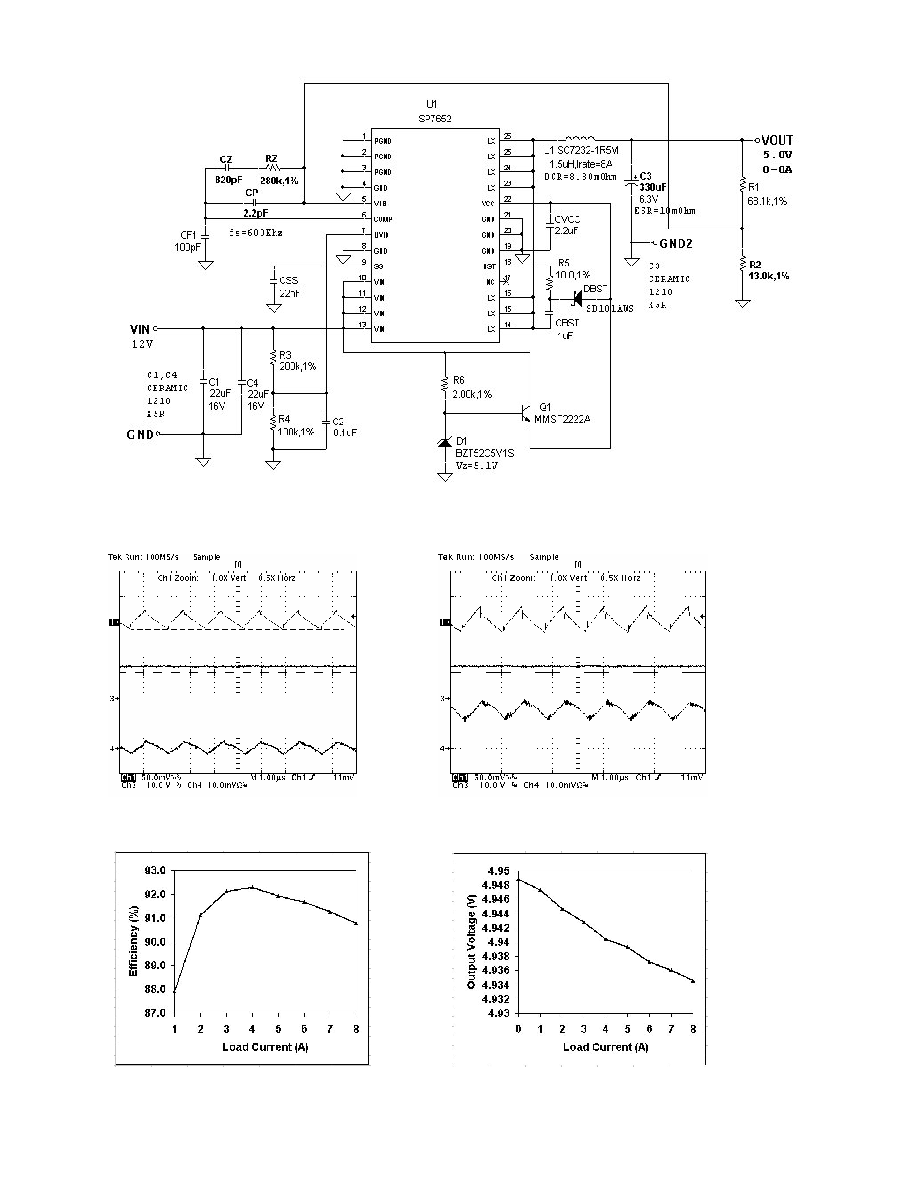
11
Figure 15. SP7652EU with Tantalum Output Capacitor Configures for +5V Output
Figure 16. Output Ripple: No Load Figure 17. Output Ripple: 8A Load
Figure 18. Efficiency vs Load Figure 19. Load Regulation
Vout ripple = 35mV
Vin
Ichoke(5A/div)
Vout ripple = 53mV
Vin
Ichoke(5A/div)
Vin=12V
Vout=5.0V
Vin=12V
Vout=5.0V
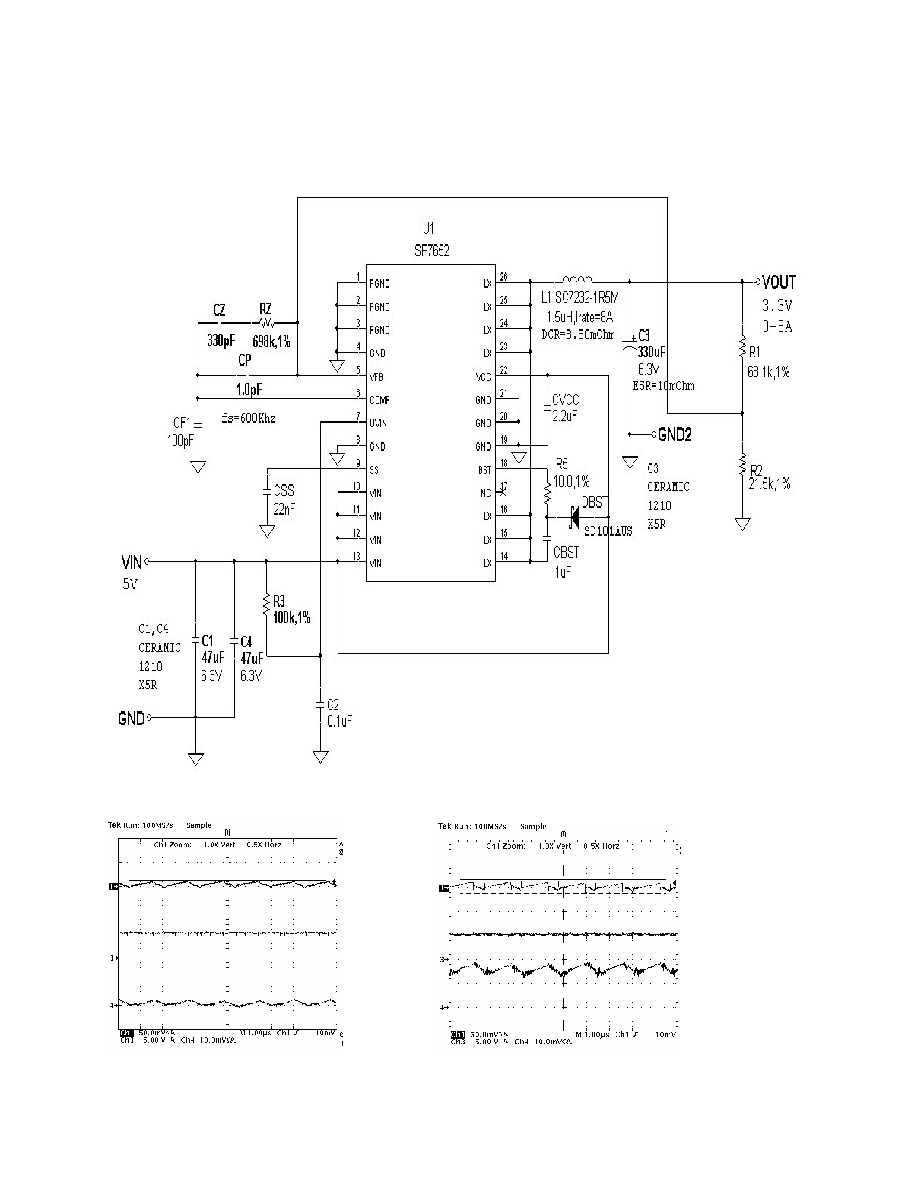
12
+5V INPUT WITH A TYPE II COMPENSATION APPLICATION SCHEMATIC
SP7652EU with Tantalum output capacitor configures for Vin = 5V, Vout = +3.3V at 0-
8A output current. Figure 21 and 22 show output voltage ripple less than 30mV at no
load to 8A load. Figure 23 and 24 show typical 94% efficiency and 0.3% load regulation
plots with a Type II compensation application circuits.
Figure 20. SP7652EU with Tantalum Output Capacitor Configures for +5V Input
Figure 21. Output Ripple: No Load Figure 22. Output Ripple: 8A Load
Vout ripple = 16mV
Vin
Ichoke(5A/div)
Vout ripple = 30mV
Vin
Ichoke(5A/div)
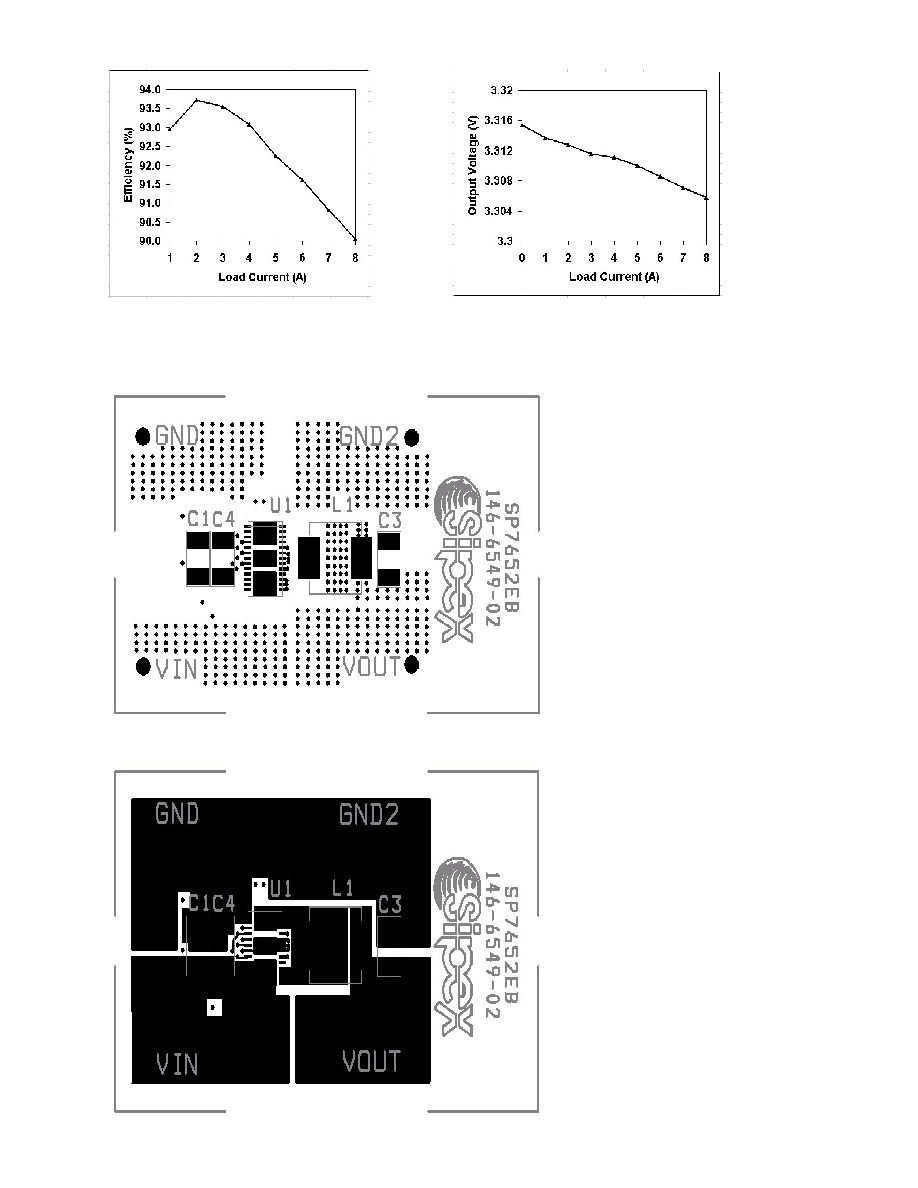
13
Figure 23. Efficiency vs Load Figure 24. Load Regulation
PC LAYOUT DRAWINGS
Figure 25. SP7652EB Component Placement
Vin=5.0V
Vout=3.3V
Vin=5.0V
Vout=3.3V
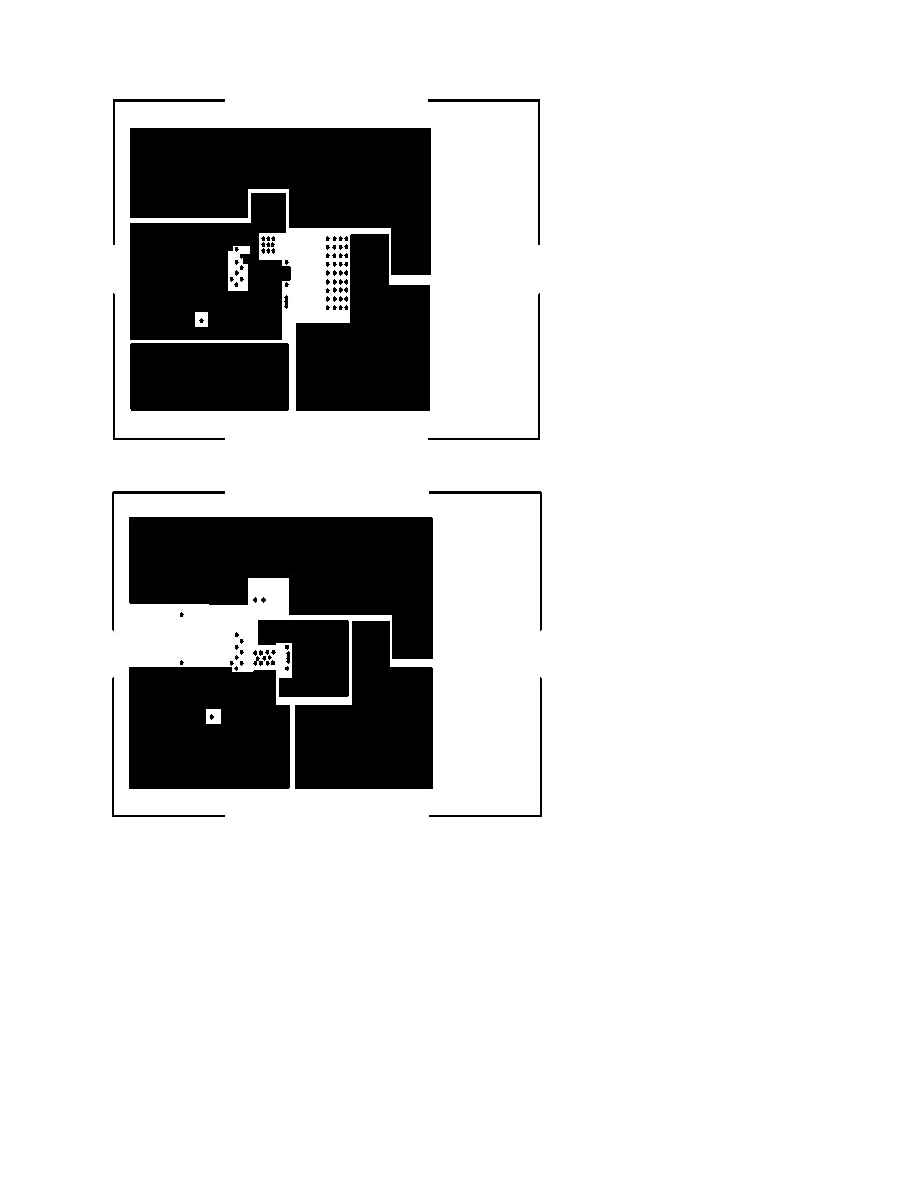
14
Figure 26. SP7652EB PC Layout Top Side
Figure 27. SP7652EB PC Layout 2
nd
Layer Side
Figure 28. SP7652EB PC Layout 3
rd
Layer Side
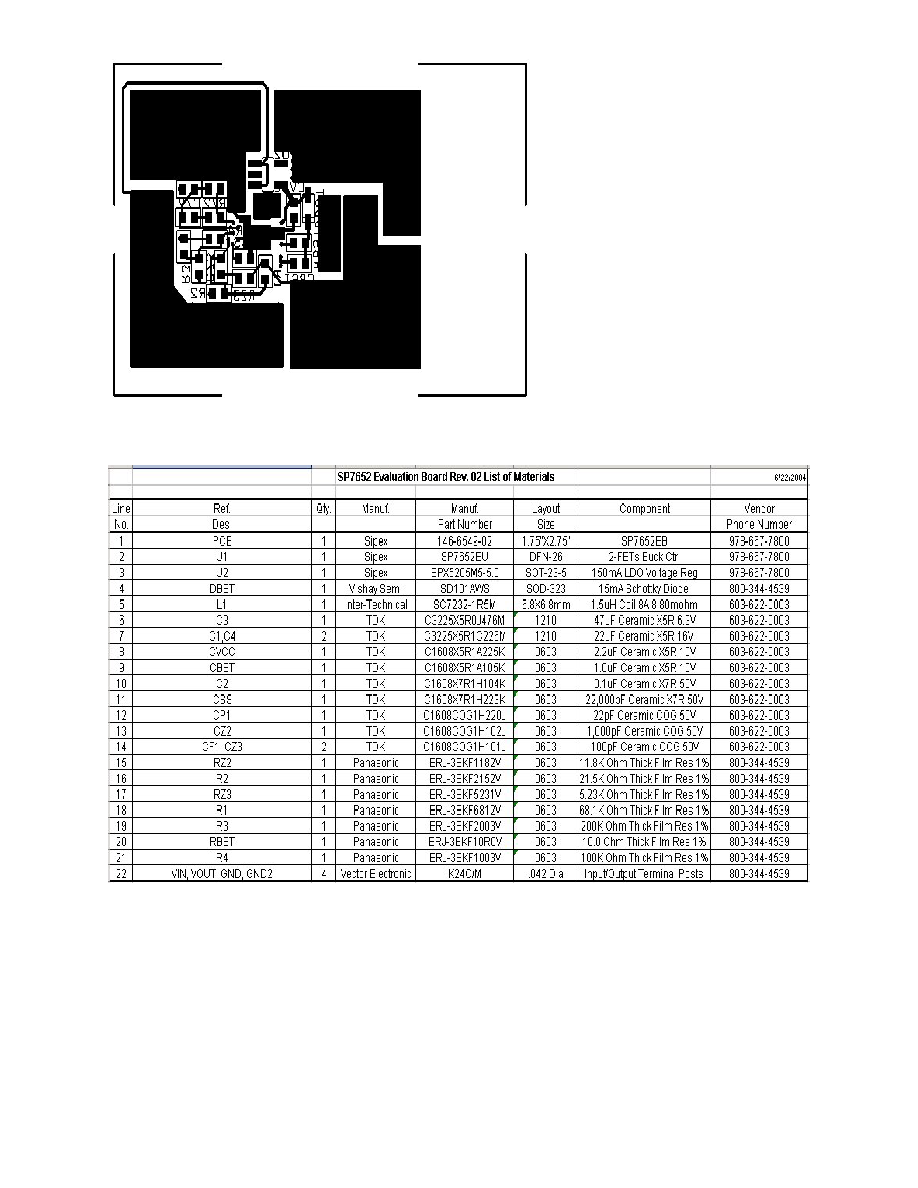
15
Figure 29. SP7652EB PC Layout Bottom Side
Table 2: SP7652EB List of Materials
ORDERING INFORMATION
Model
Temperature Range
Package Type
SP7652EB...................................-40
°C to +85°C..................SP7652 Evaluation Board
SP7652EU.................................. -40
°C to +85°C.......................................26-pin DFN














